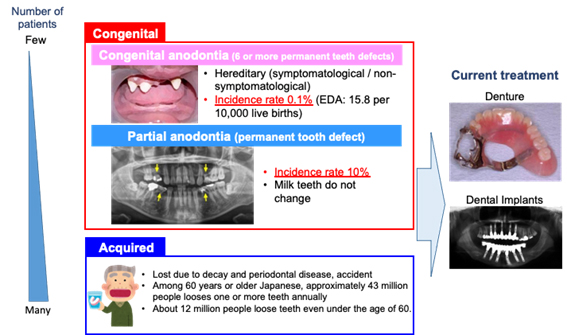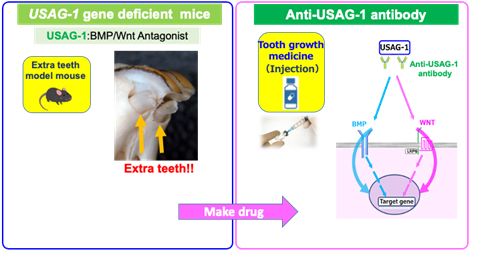Our Research & Development
Problem: Tooth Disorder
It is known that teeth are lost because of congenital or acquired reasons.
Congenital tooth loss does not grow permanent tooth buds. Approximately 10% of patients with hereditary congenital tooth defect and partial tooth loss happen to be diagnosed when the patients visit a pediatric dentist for treatment of tooth loss.
Acquired is a tooth loss due to decay or periodontal disease, and the annual number of people who lose one or more teeth among 60 years or older in Japan, is more than 43 million.

Our Challenge: Tooth regeneration & the KEY molecule
First breakthrough came in 2007 when a model mouse with supernumerary teeth (more teeth than usual) was discovered.
USAG-1 gene deficiency was found to be the cause for supernumerary teeth in the model mouse. Additional teeth were found to grow from the surviving tooth buds, which normally degenerate and disappear. Until then, some gene-deficient mice with fewer teeth were known, but mice with more teeth were very rare.
Based on the mouse findings, we asked ourselves if teeth could be regenerated in humans with congenital and/or acquired tooth defects by inactivating USAG-1 protein with a drug. To test the hypothesis we used mouse anti-USAG-1 antibodies to check the biological activity of antibodies. Currently, we are humanizing three antibodies that are effective in growing teeth when administered to mice and dogs with less number of teeth.

Solutions! : Products and Services
With our innovative breakthrough, we would like to introduce a tooth regeneration drug for people with tooth defects across the world.
Based on the gene status, our aim is to inject one shot antibody to treat congenital or partial anodontia patients for tooth regeneration.

